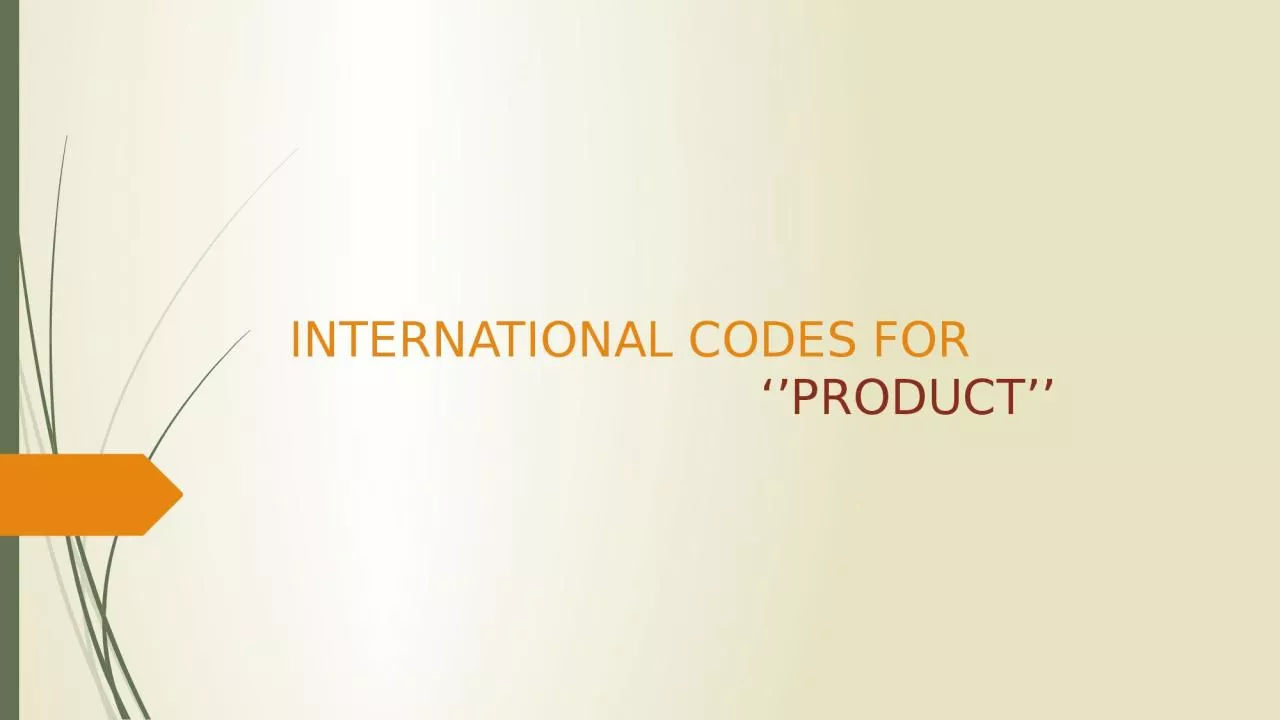

PRODUCT International codes for product Statistical Classification of Products by Activity CPA Harmonized System HS Central Product Classification CPC Combined Nomenclature ID: 1009363
Download Presentation The PPT/PDF document "INTERNATIONAL CODES FOR" is the property of its rightful owner. Permission is granted to download and print the materials on this web site for personal, non-commercial use only, and to display it on your personal computer provided you do not modify the materials and that you retain all copyright notices contained in the materials. By downloading content from our website, you accept the terms of this agreement.
1. INTERNATIONAL CODES FOR ‘’PRODUCT’’
2.
3. International codes for product:Statistical Classification of Products by Activity (CPA)Harmonized System (HS)Central Product Classification (CPC)Combined Nomenclature (CN)
4. International Product Codes:Product Classification systems organize products using standardized coding systems.There are several different classification systems that each classify products using alpha-numerical designations.There is not a universal product classification system and therefore the systems used in a particular country will vary.
5. Statistical Classification of Products by Activity (CPA): The Statistical Classification of Products by Activity (CPA) is the classification of products (goods as well as services) at the level of the European Union (EU). Product classifications are designed to categorize products that have common characteristics. They provide the basis for collecting and calculating statistics on the production, distributive trade, consumption, international trade and transport of such products CPA product categories are related to activities as defined by the Statistical classification of economic activities in the European Community (NACE).
6. Each CPA product - whether a transportable or non-transportable good or a service - is assigned to one single NACE activity. This linkage to NACE activities gives the CPA a structure parallel to that of NACE at all levels. What are CPA Codes used for?The internal market requires statistical standards applicable to the collection, transmission and publication of national and community statistics.Enables enterprises, financial institutions, governments and all other operators in the internal market can be provided with reliable and comparable statistical data.
7. Harmonized System (HS):The Harmonized Commodity Description and Coding System (Harmonized System or HS) is a multipurpose international product nomenclature developed by the World Customs Organization (WCO). It comprises about 5,300 commodity groups each identified by a six digit code, arranged in a legal and logical structure and is supported by well-defined rules to achieve uniform classification. The HS is a universal economic language and code for goods, and an essential tool for international trade.The Harmonized System is governed by "The International Convention on the Harmonized Commodity Description and Coding System".
8. What is HS used for?Used by more than 200 countries and economies as a basis for their Customs tariffs and for the collection of international trade statisticsOver 98% of the merchandise in international trade is classified in terms of the HSThe HS contributes to the harmonization of Customs and trade proceduresIt also contributes to the non-documentary trade data interchange in connection with such procedures, thus reducing the costs related to international trade.It is also extensively used by governments, international organizations and the private sector for many other purposes such as:
9. Internal taxesTrade policiesMonitoring of controlled goodsRules of originFreight tariffsTransport statisticsPrice monitoringQuota controlsCompilation of national accountsEconomic research and analysis
10. Central Product Classification (CPC):The CPC constitutes a comprehensive classification of all products, including goods and services. CPC presents categories for all products that can be the object of domestic or international transactions or that can be entered into stocks. It includes products that are an output of economic activity, including transportable goods and non-transportable goods, products, and services.
11. Why are CPC Codes used?To provide a basis for recompiling basic statistics from their original classifications into a standard classification for analytical useTo enhance harmonization among various fields of economic and related statisticsTo strengthen the role of national accounts as an instrument for coordination of economic statistics
12. Combined Nomenclature (CN):CN stands for Combined Nomenclature. It is the common nomenclature of the European Community and is an 8-digit product classification system used in export declarations and in statistical declarations for trade in the European Community. All products and goods exported from the European Union or imported into European Union must be classified for Customs purposed. Every product will be assigned to a particular product classification code. Changes to the nomenclature occur every year and are updated and reflected into the nomenclature at the beginning of the following year.The CN is comprised of the Harmonized System (HS) nomenclature with further Community subdivisions.
13. What are CN codes used for?Collection and publishing of products and goods statistics for both intra and extra CommunityCustom tariffs (Article 9 of the Treaty establishing the EEC) determined by the subheading of the nomenclatureLaws on agricultural mattersTrade negotiations
14.